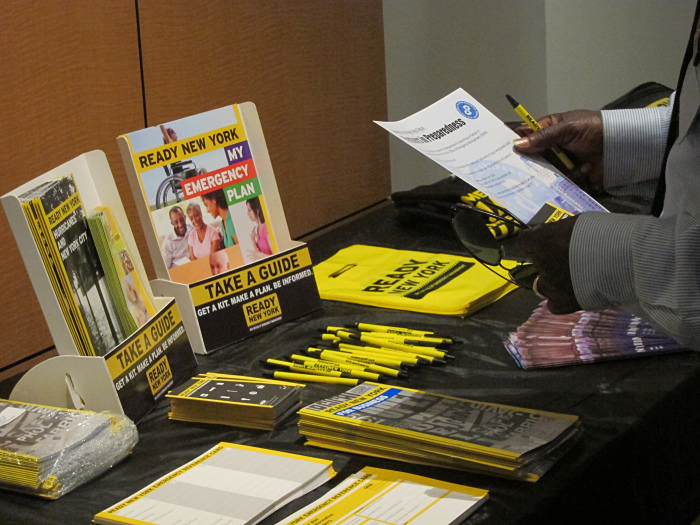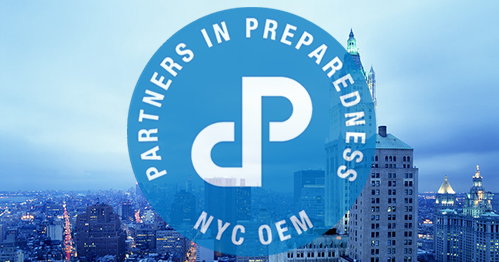You are here
Solving a Communication Gap with Partners in Preparedness
CDC Foundation and the Learning Office of CDC’s Office of Public Health Preparedness and Response selected seven communities that are promising examples of community efforts that reflect and embody FEMA’s Whole Community Approach to emergency management. The New York Office of Emergency Management Partners in Preparedness program was selected as one of the promising examples.
 When asked, leaders in communities everywhere will say that communication is by far the biggest problem during an emergency. However, communication is such a broad term that it does not pinpoint the problem. For instance, are communication problems caused by communication systems, like phone lines and cell towers or is it the communication you receive or try to obtain in an emergency? Is it communication to the people you are responsible for or is it the communication from the people you are responsible for? So, how do we go about addressing these multi-faceted issues? Start small and focus on one solution to one communication problem.
When asked, leaders in communities everywhere will say that communication is by far the biggest problem during an emergency. However, communication is such a broad term that it does not pinpoint the problem. For instance, are communication problems caused by communication systems, like phone lines and cell towers or is it the communication you receive or try to obtain in an emergency? Is it communication to the people you are responsible for or is it the communication from the people you are responsible for? So, how do we go about addressing these multi-faceted issues? Start small and focus on one solution to one communication problem.
The New York City Office of Emergency Management (OEM) has instituted the Partners in Preparedness program. OEM's Partners in Preparedness program is designed to help organizations in the New York City metro area better prepare their employees, services, and facilities and develop a trusted communication system before disaster strikes. To become a Partner, an organization must complete five preparedness activities (three required and two additional) and report their actions through a partner survey. Only then will the organization become an official partner and obtain a Partners in Preparedness seal.
The three required activities are:
1: Stay Connected – Encourage coworkers and volunteers to sign up for Notify NYC, the city’s free, real-time emergency notification system.
2: Get Prepared – Set up and test an emergency contact plan or calling tree for your organization.
3: Send Preparedness Messages – Use e-mail, Facebook, Twitter, or your website to test and send preparedness messages to your employees.
To make the process simple and streamlined, the OEM provides marketing materials, samples, and pre-approved messaging for each activity. The end result is a larger pool of people better connected to a trusted information source prior to, during, and after an emergency. Added benefits to becoming a Partner in Preparedness include:
- Highlighting the dedication to the safety and well-being of employees and their families.
- Gaining tools and resources to prepare organizations for all types of emergencies.
- Receiving emergency updates from OEM.
- Displaying an official seal from OEM to demonstrate commitment to emergency preparedness.
 Shearman & Sterling, LLP, an international law firm with a worldwide presence of some 1,000 attorneys in 20 offices around the world, is headquartered in midtown Manhattan and is an official Partner in Preparedness.
Shearman & Sterling, LLP, an international law firm with a worldwide presence of some 1,000 attorneys in 20 offices around the world, is headquartered in midtown Manhattan and is an official Partner in Preparedness.
“During Hurricane Sandy, the support we received from Partners in Preparedness was incredible,” says Toni Reiffe, Shearman and Sterling’s Business Continuity Manager. Reiffe adds that the information from Partners in Preparedness was constant and reliable before, during and after the storm. “We knew what city services were impacted and were able to get that information directly to our employees. We opened our doors on Wednesday after Sandy because people needed to come back to work in order to continue serving our clients in New York and around the world. Even people with direct hits to their homes came into the office. People needed to get back to normal.” Reiffe states that she knew that the OEM had their work cut out for them with the displacement of individuals, families and businesses that were affected but, thanks to Partners in Preparedness, Shearman & Sterling was essentially self-sufficient and not a drag on OEM’s stretched resources.
Shearman & Sterling set an example by taking key steps prior to an emergency by becoming a Partner in Preparedness, thus providing a more resilient organization for their staff and to the community at large. Reiffe points out that business continuity has graduated from just the practice of IT system redundancy to all systems and practices of keeping a business operational in an emergency. A big part of that, she says, is the personal preparedness of staff. “In an emergency, someone who is prepared has a better chance to help the firm,” says Reiffe. She is raising the preparedness awareness level of individuals at her firm one person at a time.
The Partners in Preparedness program was selected as one of the promising examples of the Whole Community Approach to Emergency Management by CDC and the CDC Foundation. Please visit CDC's website for more information about Partners in Preparedness and the Whole Community Program.
View this post on CDC's website.